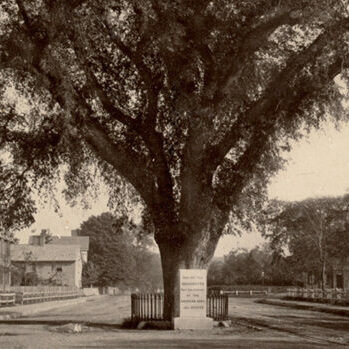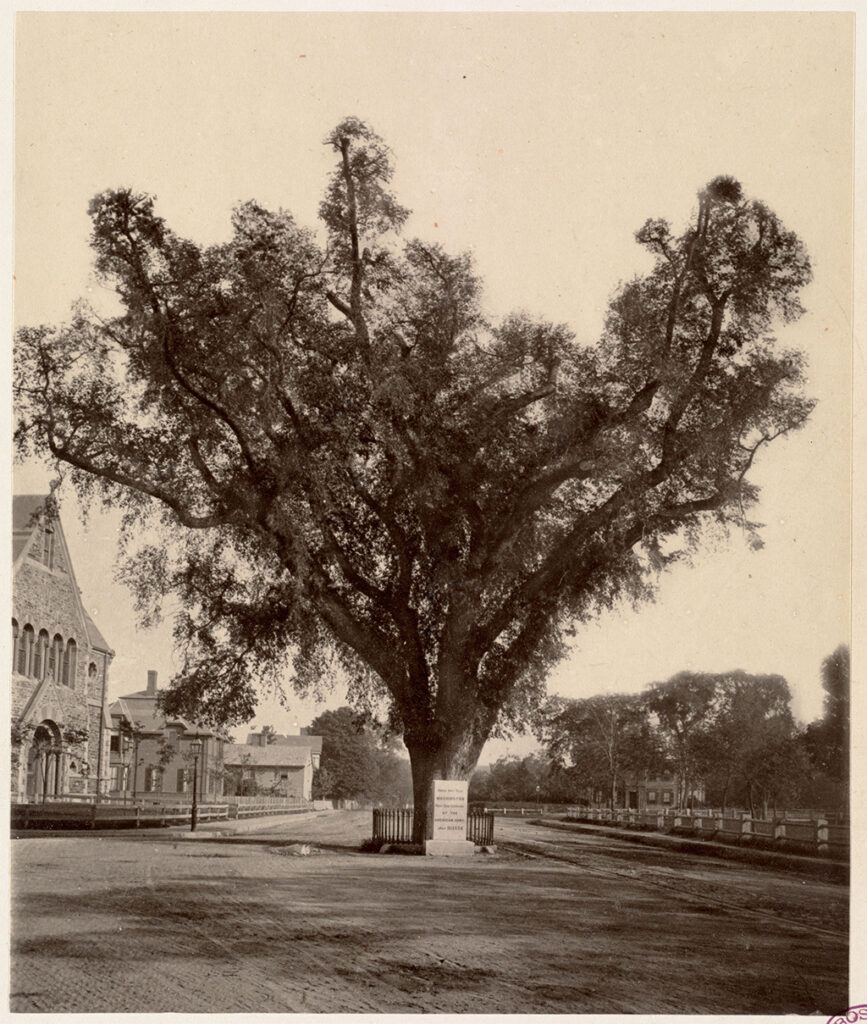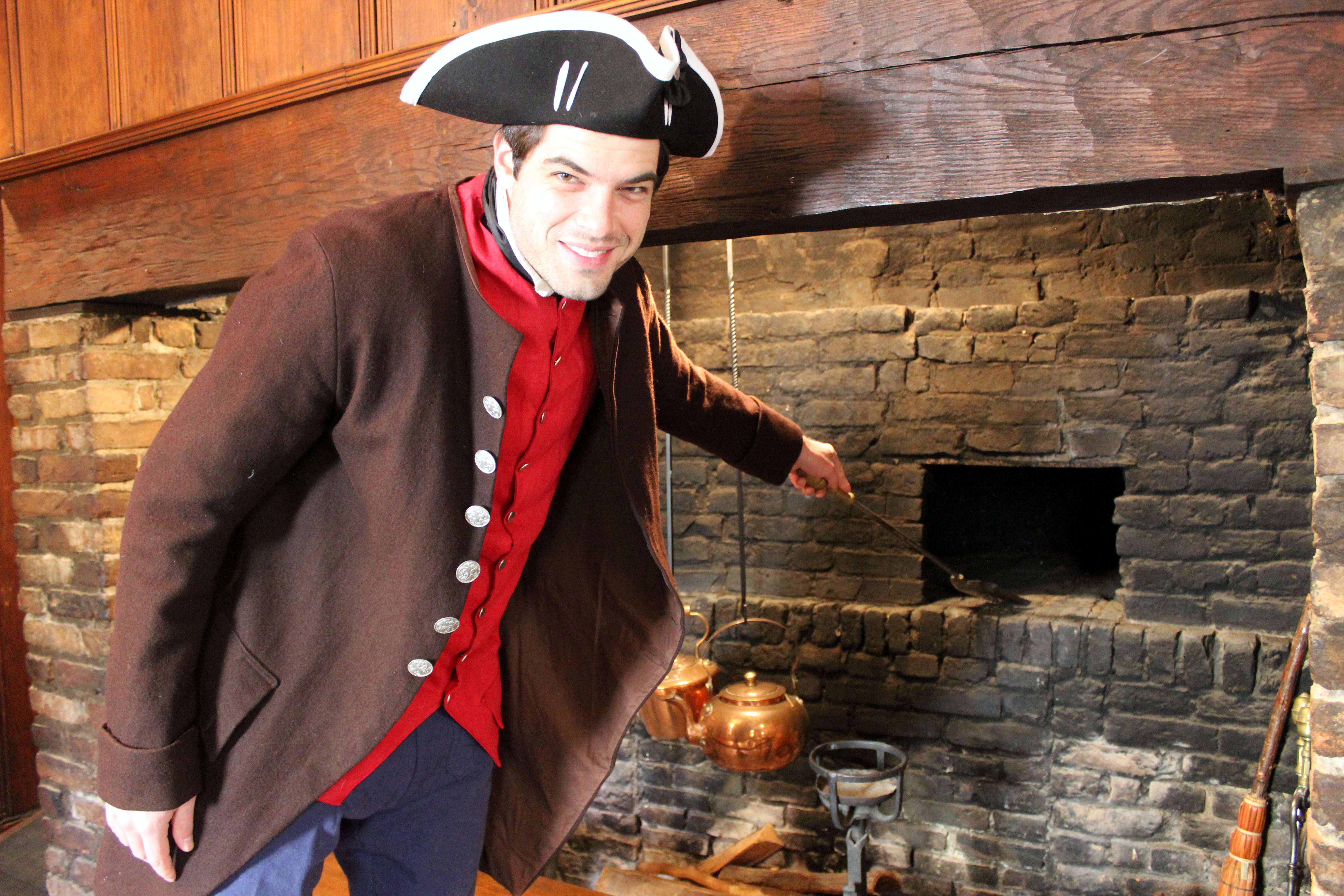
The Washington Elm fell near 100 years ago, living symbol of liberty and site of reverence

The headline in the Oct. 27, 1923, Cambridge Tribuneproclaimed it: “The Old Elm is Down.”
The previous day, city workers had been attempting to remove a dead limb from the large tree on Cambridge Common known as the Washington Elm when the main trunk, weakened from decades of decay, split and sent the tree crashing to the ground.
News of the elm’s demise dominated the headlines of every area paper in the week that followed, with everyone from politicians to scientists to local schoolchildren giving their opinion on the tree’s fate and its enduring place in history.
What was the Washington Elm, and how did it attain such a powerful hold over the popular imagination in Cambridge and well beyond?
The tree began as a seedling on Cambridge Common in the 1720s or 1730s – the estimate of scientists counting its rings after it was taken down. On July 3, 1775, Gen. George Washington assumed control of the Continental Army in Cambridge, with legend holding that this ceremony took place under the sprawling branches of the then-mature elm tree.
The portrayals of Washington taking command on the Common are likely accurate – soldiers had been encamped on the Common awaiting Washington’s arrival, and the area’s open space and central location would have been a logical place to hold such an event, which would have attracted many onlookers. But there is no mention of the elm’s place in the story until the mid-19th century, when the “discovery” of a diary entry dated July 3, 1775, purported to place its author on Cambridge Common when Washington assumed command of the army under the elm.
Over the almost two centuries since the introduction of the Washington Elm into the story of that day, its veracity has been questioned by many. And yet, the tree has maintained its allure as a symbol of liberty and a site of reverence for residents and visitors alike.
Why was the Washington Elm so important to the people of Cambridge? And why did so many continue to hold fast to the idea of its presence at the birth of the American army, even long after it had fallen? What is it about a tree – a living being – that feels different from a memorial of stone or metal? The many accounts of the Washington Elm that have been published over the centuries refer to the tree as a “witness to history,” somehow absorbing the sights, sounds and feelings of that day in 1775 into its very being and allowing those who visited it to soak in a bit of that history by being in its presence.
From the mid-19th century onward, the elm itself (and, later, the site where it once stood) has functioned as a touchstone for historical memory and as a place for Cantabrigians to gather in times of turmoil or celebration. Just after the first shots of the Civil War were fired on Fort Sumter, South Carolina, in the spring of 1861, the Cambridge Chroniclenoted that “Last Saturday afternoon, almost everybody in the streets appeared to be traveling towards one point – the Washington Elm, near Cambridge Common … The people of Cambridge assembled to determine measures in aid of the government demanded by the startling events now transpiring. The venerable elm was decorated with ancient regimental standards, and a shield of liberty, and draped with flags.” To Cambridge residents, the struggle of the Union forces and the national government in the fledgling Civil War was comparable to that of the colonists against British rule in the 1770s; the shade of the Washington Elm was the logical place for them to gather and invoke that spirit of liberty in a battle against tyranny and oppression.
In the century and a half that has followed that Civil War gathering, the site of the elm has served as a necessary stop for visitors from other parts of the country and abroad on visits to the city. The site has hosted visiting dignitaries too; as late as 1993, Cambridge Historical Commission assistant director Erika Bruner noted in a letter to the Chroniclethat “we field more inquiries about the tree than about any other single Cambridge landmark.” During the marking of Cambridge’s transition from town to city in 1846 (as well as its anniversaries in 1896, 1946 and 1996), the centennial and bicentennial of the Revolution (1876 and 1976, respectively), and the celebrations of Washington’s birthday, the site of the elm was a stop for parades and ceremonies.
The elm has also served as an important site for communal gatherings and even protests. In the Civil War and World Wars I and II, Cambridge held ceremonies for soldiers going off to war, hoping that the “spirit of liberty” quite literally rooted in that place and its memory would guide them on their travels. As recently as 2005, at a ceremony marking the 230th anniversary of the American Army (so marked because of Washington’s assumption of command there in 1775), a group of protesters chanted in opposition to the army’s policies in Iraq and Afghanistan in the wake of the 9/11 terrorist attacks. In an editorial in the Chronicle, a reporter argued that “the juxtaposition of the groups showcased two freedoms for which the original Continental Army fought: our country’s right to protect itself; and the rights of its citizens to express their opinions.”
Long before the Washington Elm met its final demise, disease and decay took their toll, causing branches of all sizes to fall during storms and high winds. Cambridge papers feature many reports of “relic hunters” rushing to scoop up pieces of the tree, as they did en masse when it finally fell. The wood from the elm was used to make everything from gavels and pens for state legislatures and foreign governments to bookends, picture frames, chairs and myriad other commemorative items. Used in ceremonies and gifted to visiting dignitaries and celebrities, these souvenirs became so numerous that the local papers often joked that, if reassembled, the elm’s many “authentic” pieces would form a tree more than double its actual size.
Although the Washington Elm has been gone in its living form for a century, making it dimmer in the minds of present-day Cantabrigians than to their ancestors, it remains a potent symbol – one that serves to place Cambridge at the center of the story of the nation’s founding. As we commemorate the centennial of its fall, the elm raises important questions about the city’s place in the Revolutionary story, as well as the unique role a living entity can play in the development of a city’s – and a nation’s – understanding of its own history.
We look forward to exploring these and other ideas about Revolutionary commemorations over the next several years as we approach the 250th anniversary of the Declaration of Independence. Sign up for our newsletter to stay up to date on upcoming events, articles and programs, and we look forward to making history with you.
Beth Folsom is programs manager for History Cambridge.
This article was originally published in our “Did You Know?” column in Cambridge Day.





